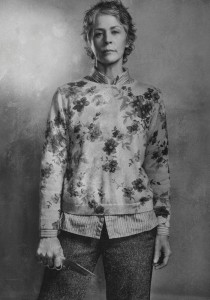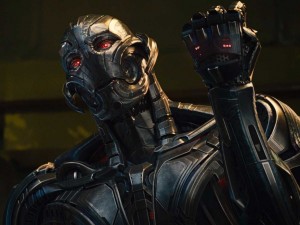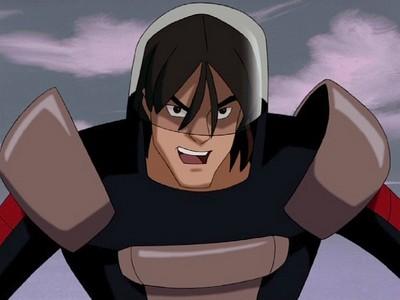With thousands of heroes and villains and decades of history, it’s easy for some comics characters to be forgotten, or underappreciated. Sometimes it’s a question of the right interpretation, or the right performance, in another medium to really make the character “click.” This week, Deadshirt contributors looked at their favorite lesser-known characters who have flourished in adaptations.
Carol – The Walking Dead
In The Walking Dead comics, Carol was a character with a short, sad arc whose purpose seemed to be simply to demonstrate how some people (often women) just couldn’t handle this new world. She is the wife of an abusive husband who, thankfully, dies pretty early on, though she continues to suffer from the fallout. She has a brief moment of happiness with a new man until he leaves her for another woman, so she spirals, begging Rick and Lori to let her into their marriage before eventually committing suicide-by-zombie in front of her friends and daughter.
This event would have taken place in Season 3 of The Walking Dead TV series if these two Carols were anything alike. Thankfully, TV Carol is reborn like a phoenix from the ashes of her pitiful precursor, becoming the most compelling and complicated woman on the show. Unlike Michonne, the heroic and steadfast female lead, Carol is dark. She becomes a chameleon, taking advantage of her stay-at-home-mom vibe to appear weak to those who don’t know her. It was incredible to feel so completely unnerved at the sight of this woman, who had killed children and taken on an entire compound of cannibals by herself, wearing floral cardigans and baking cookies for her new neighbors last season. This same character who couldn’t handle her shit in the comics had become terrifying on television, and I can’t get enough of her.
A newcomer and potential lover to Carol told her this season that she was like the group’s mother, because she protected them and took care of them like a mother would. Carol, bless her, rejects this. Her only child died; it’s no longer a part of her identity. What Carol’s friend is confusing for motherly instinct is plain old love. In order to protect the people she loves, she has to get good at killing, and she gets so good that she becomes afraid of herself. She knows she can’t have one without the other, so to save her own soul she tries to leave, something she has tried and failed to do in the past. By rejecting that motherly label, however, Carol is subverting a common female trope (no one accuses Daryl of being the group’s dad despite sharing the same traits) while exploring how far a character can be pushed in ways women rarely get to do on screen.
Actress Melissa McBride has really demonstrated her range, taking Carol from a scared housewife to a murderer to a woman unhinged. Every season she delivers my new favorite character moment without fail. I look forward to how the show will top Carol whimpering to a truck full of armed men to let her go, not because she’s afraid to die but because she knows she’s going to kill them all.
–Sarah Register
Ultron – Avengers: Age of Ultron
I know, I know. With a long history of archvillainy and a feature crossover event just a few years ago, Ultron isn’t exactly a B- or C-list character. But I have to admit, as much as I liked the idea, I was never quite sold on Ultron. Maybe it was the Jack O’Lantern-like face, or the increasingly convoluted schemes. But Age of Ultron, for all its faults, delivered a version of the character who I finally understood completely.
The MCU version of Ultron is a little different from the comics. He’s a creation of Tony Stark instead of Hank Pym, he has an expressive, sneering face, and (spoilers) he’s a one and done deal. But the core of the character is the same, and it’s the part that finally fell into place for me: Ultron isn’t a cold, mechanical villain, like a Terminator or Cyberman. He’s an unstable, rage-driven megalomaniac, who also happens to be a machine. He loses his temper and yells, but also occasionally shows remorse and concern for other characters. James Spader’s mannerisms are strange, to be sure, but they’re a very human, emotional kind of strange. And if he was a little too quippy (which isn’t a complaint I have, but one I can understand), it just cements his status as mercurial madman instead of logic-driven engine.
The lasting effect of the AoU take was that it became a lens though which I could revisit and more deeply understand older comics stories starring the character. I finally understood that when he comes to claim Victor Mancha in Runaways, it’s not as assimilation, but a nervous scientist trying to bond with his erstwhile son. Spader’s smirking delivery resonated through older stories, as well as later books, like the Ultron collective in Secret Wars. Seeing a film put an actual face and voice to Ultron broke down the barrier preventing me from truly getting inside his head.
–Joe Stando
Avalanche – X-Men: Evolution
When X-Men: Evolution premiered in 2000, it was an X-Men cartoon for the aughts as much as the Fox series was the X-Men for the nineties, trading in pouches and spandex for flared jeans and teen angst. Reimagining the X-Men as high school students, it was not a show for the die-hard comic purist, but it successfully used mutation as a metaphor for the pangs of adolescence and punctuated the usual high school drama of crushes and cliques with telekinesis and deadly eye beams. X-Men: Evolution’s focus on characters and relationships led to bold new takes on many popular mutants (most famously, Goth Rogue), but was most revelatory in how it developed a character that wasn’t even an X-Man: the earthshaking Brotherhood of Mutants’ member Avalanche.
As a comic book villain, Avalanche has an impeccable pedigree, first appearing in nothing less than Chris Claremont and John Byrne’s “Days of Future Past.” Though he would frequently appear throughout the decades as a member of the Brotherhood of Mutants, Freedom Force, and X-Corp, he was rarely given depth, primarily existing as a punchable henchman. Rechristening Dominic Petros as Lance Alvers (oh, that pun!), X-Men: Evolution reconfigured Avalanche as the teenage bad boy from the wrong side of the tracks—more John Bender than John Byrne. Avalanche would prove to be a perfect foil to Cyclops, grungy and temperamental where Cyclops was clean cut and in-control. Despite the show’s endearing cheesiness—his own rock guitar leitmotif, a bevy of “Let’s rock!” puns—Avalanche developed into a character with surprising depth, eventually becoming the Brotherhood’s reluctant conscience.
The most surprising revelation is Avalanche’s blossoming romance with Kitty Pryde, a plot twist unthinkable in the comics. Yes, it’s the stuff of teen movies, good girl falling for the bad boy and all that, but juicy relationship drama makes teen girls swoon for a reason. “Members of the X-Men and Brotherhood fall for each other” is the kind of epic, star-crossed soap opera the X-Men comics live for, providing scenes of both sweetness and tension. Could their affection survive the ideological differences between the X-Men and the Brotherhood? We get our answer in X-Men: Evolution’s final episode. By breaking way from the comics’ limited portrayal of Avalanche, the animated series gave us the definitive version of the character. Evolution, indeed.
–Kayleigh Hearn
Foggy Nelson – Daredevil
Although Foggy Nelson has been around for as long as Daredevil himself—his first appearance was in Daredevil #1, after all—Foggy’s never fully worked for me as a character until his live action appearance on Netflix’s Daredevil. Comics Foggy has always been a reliable wet blanket/plot contrivance for Matt Murdock, someone to get kidnapped by Mr. Hyde or blackmailed by HYDRA or otherwise let down by Matt’s double life as Daredevil. Elden Henson’s take on the character keeps enough of that while also making him a charming, nuanced character in his own right.
Henson and Charlie Cox’s onscreen friendship as the primaries of Nelson & Murdock is impressive because it feels so effortless; you pretty immediately buy into their history together well before we ever see any on-screen superheroics. And while Daredevil’s second season is memorable for a killer Punisher arc and ninja demon death cult hijinks, it’s Henson’s work as Foggy that really grounds the show. The unraveling of Foggy and Matt’s friendship is painful to watch not just because we like these characters, but because Henson’s Foggy is watching his best friend ignore his desperate pleas to stop killing himself every night. In a lesser show, the moment when Foggy attempts to throw out Matt’s Daredevil togs after begging him to give up his alter ego would’ve been a joke; Henson and Cox play it as the exact moment their professional and personal relationship begins to implode.
More than just being a great foil to Matt/Daredevil, Netflix’s affable version of Foggy Nelson feels like a character who would actually exist in 2016, as opposed to his comics counterpart, who even fifty years later just sort of looks like an overgrown College Republican. Henson masks Foggy’s considerable competence as an attorney behind a jokey stoner veneer, a put-on to hide his insecurities and fears around Matt, Karen, and the world at large. When we see Foggy at the end of Season 2 with a more professional haircut, a better suit and a new gig as a high-powered corporate lawyer, it’s kind of shocking. While Matt Murdock himself is fairly static as the show’s lead, Foggy Nelson’s rather profound growth over two seasons is quietly Daredevil’s most interesting accomplishment to date.
–Max Robinson
Cisco Ramon / Vibe – The Flash
When The Flash started on CW and modeled itself after Arrow’s “hero flanked by a small team” archetype, the fact that the nerdier science guy was also Vibe from ’80s Justice League comics seemed more like a punchline than potential. Raise your hands if you were legitimately excited about motherfucking VIBE being on a live action series. Keep them raised if your name isn’t “Geoff Johns.” Yeah, that’s what I thought.
Even from those first few episodes, Cisco, though a welcome presence on the show, was far from a breakout character. He’d deliver all of the goofy little reference jokes the writers can’t restrain themselves from throwing in and his chemistry with the rest of the cast was palpable, but there wasn’t much special to him. Honestly, if they hadn’t taken the time to name him after a character from the comics with powers, I’d have worried about his mortality every time he was in danger, such was the throwaway nature of his involvement. But as the series has progressed over the past season and a half, more and more of actor Carlos Valdes’s natural charisma began to seep into this portrayal.
The writing staff found more meaningful things to occupy Cisco’s screen time, which helped his overall importance to the show, but it’s Valdes himself who deserves the credit for making the character so lovable and magnetic. Even though nerd culture is so mainstream, the “science savvy sidekick” type is still often portrayed as this awkward, socially crippled mutant who can barely function outside of expository dialogue and occasionally ending up in peril. Valdes plays Cisco as clever, enigmatic, and likable in a way few television characters can organically be. From a diversity perspective, the Colombian-American performer has given life to an otherwise thankless role that allows geeky Latinos to see a real semblance of themselves up on the screen. He never comes off as a caricature because Valdes is putting so much of himself in front of the camera.
Only time will tell if anyone on the publishing side figures out a way to distill his unique charm into his funnybook counterpart.
–Dominic Griffin






